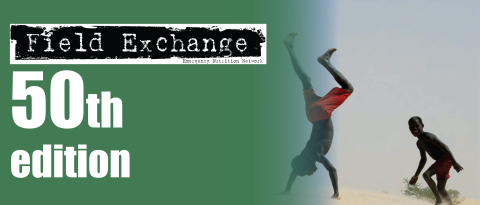Promoting community based management of severe acute malnutrition as a child survival intervention
By Andre Briend
Andre is Adjunct Professor at the Department for International Health, University of Tampere School of Medicine, FIN-33014, Tampere, Finland and Department of Nutrition, Exercise and Sports, Faculty of Science, University of Copenhagen, Rolighedsvej 30, DK-1958 Frederiksberg, Denmark
Striking the balance between prevention and treatment is one of the most difficult tasks for public health nutritionists working in poor countries. A key element to make decisions is to consider the potential impact of different interventions and also their cost-effectiveness. In this regard, management of severe acute malnutrition (SAM) stands out as it saves lives, whereas the effect of other interventions is often to marginally increase weight or height gain, with small or immeasurable effects on mortality. This was highlighted by an article of the Lancet series which suggested that SAM management is the most cost-effective nutrition interventions to prevent malnutrition related deaths.1 These results are important, but should receive confirmation, as the evidence base to support this claim is indirect and arguably weak compared to standards used to evaluate other health interventions. SAM treatment is typically one of these interventions for which a solid evidence base relying on a meta-analysis of a series of randomised controlled trials will never be available. This is a rather common situation in nutrition where waiting for this type of strong evidence is impossible or even unethical.2 3 Estimates of the number of deaths prevented by SAM treatment given by the Lancet series are based on observation of mortality reduction in hospital settings with the progressive improvement of treatment protocols and then transfer of these treatment protocols to the community. A Delphi process to obtain consensus on these mortality estimates with and without adequate treatment from key experts was also used in the process.4 These figures are then applied to current estimates of severe wasting prevalence in different parts of the world to calculate the number of deaths which could be averted. Prevalence data, however, are notoriously inadequate to estimate the burden of acute conditions: children who are acutely ill or malnourished can have died or recovered at the time of a cross sectional survey, and will not be counted, a point which was already noted by Cicely Williams more than 40 years ago.5
The paper published in this issue of ENN’s Field Exchange trying to estimate “how many lives do our CMAM programmes save” is an interesting contribution to get evidence of effectiveness of SAM treatment. This paper is based on an approach relying as far as possible on locally obtained data which has been used previously to estimate the cost effectiveness of community based management of severe acute malnutrition (CMAM) programs in Bangladesh.6 To estimate the mortality of SAM children in absence of treatment, it relies on historical data of untreated children with a low mid-upper arm circumference (MUAC) adjusted for the level observed on admission in the programme. This approach is preferable, as MUAC is more closely related to mortality than weight-for-height. Also, programme admissions are used to estimate the number of deaths prevented. In the presence of active case finding, this gives a more reliable estimate of the SAM burden than prevalence data used in the Lancet article. Also, the authors used data on background mortality in the country to estimate the excess of deaths which would happen in the absence of treatment, which seems a reasonable approach. Costs of mortality reduction are also based on locally collected data. This is welcome, as these costs, which include staff cost, transport costs, and are influenced by the type of health system, is highly context specific.
The result of this study suggests that CMAM saves lives at a cost of US $ 274.25 per life (95% CI = US $ 227.49; US $ 344.78). There are two ways to use these results. They can be compared directly with other child survival interventions as done by the authors and this shows that CMAM is a cost effective strategy to prevent deaths. This figure can also be compared in pure economic terms with the annual Gross National Product (GDP) of the country, as recommended by WHO.7 With this approach, cost of a death averted by CMAM is less than the regional GDP and can be regarded as “highly cost-effective”.
The methodology described in this study has clear limitations as it is based on assumptions on mortality which cannot be validated. However, these estimates are the best we can have with currently available data. It is a transparent approach which can be applied to other settings. Replication of this study in other contexts will help to collect more solid evidence on the cost-effectiveness of CMAM treatment. These studies may prove a more powerful advocacy tool at the national level than current global estimates, which are always difficult to apply to the local context.
1Bhutta ZA, Das JK, Rizvi A, et al. Evidence-based interventions for improvement of maternal and child nutrition: what can be done and at what cost? Lancet 2013; 382: 452–77.
2Blumberg J, Heaney RP, Huncharek M, et al. Evidence-based criteria in the nutritional context. Nutr Rev 2010; 68: 478–84.
3Mann JI. Evidence-based nutrition: Does it differ from evidence-based medicine? Ann Med 2010; 42: 475–86.
4Lenters LM, Wazny K, Webb P, Ahmed T, Bhutta ZA. Treatment of severe and moderate acute malnutrition in low- and middle-income settings: a systematic review, meta-analysis and Delphi process. BMC Public Health 2013; 13 Suppl 3: S23.
5Williams CD. Protein-calorie malnutrition. Lancet 1972; 1: 1333.
6Puett C, Sadler K, Alderman H, Coates J, Fiedler JL, Myatt M. Cost-effectiveness of the community-based management of severe acute malnutrition by community health workers in southern Bangladesh. Health Policy Plan 2013; 28: 386–99.
7WHO | Cost-effectiveness thresholds. WHO.? (accessed April 10, 2015). http://www.who.int/choice/costs/CER_thresholds/en/


